A Study on the Impact of Workplace Diversity on Modern Organizations
VerifiedAdded on 2022/09/28
|13
|3439
|72
Report
AI Summary
This report examines the impact of workplace diversity on organizational performance, exploring its significance in the contemporary business environment. It reviews literature on the benefits of a diverse workforce, including increased productivity, creativity, and customer satisfaction. The report analyzes factors influencing the adoption of diversity, such as company type, organizational culture, and location, while also discussing strategies for managing a diverse workforce, including team building, mentorship, and diversity training. It also identifies barriers to effective diversity management, such as balancing career and family and unsupportive work environments. The research methodology includes an in-depth literature review to assess existing research on the topic. The findings highlight the critical role of diversity in fostering innovation, competitiveness, and employee growth, while also acknowledging the challenges in implementation. The report concludes by emphasizing the importance of addressing research gaps and implementing effective diversity management practices.
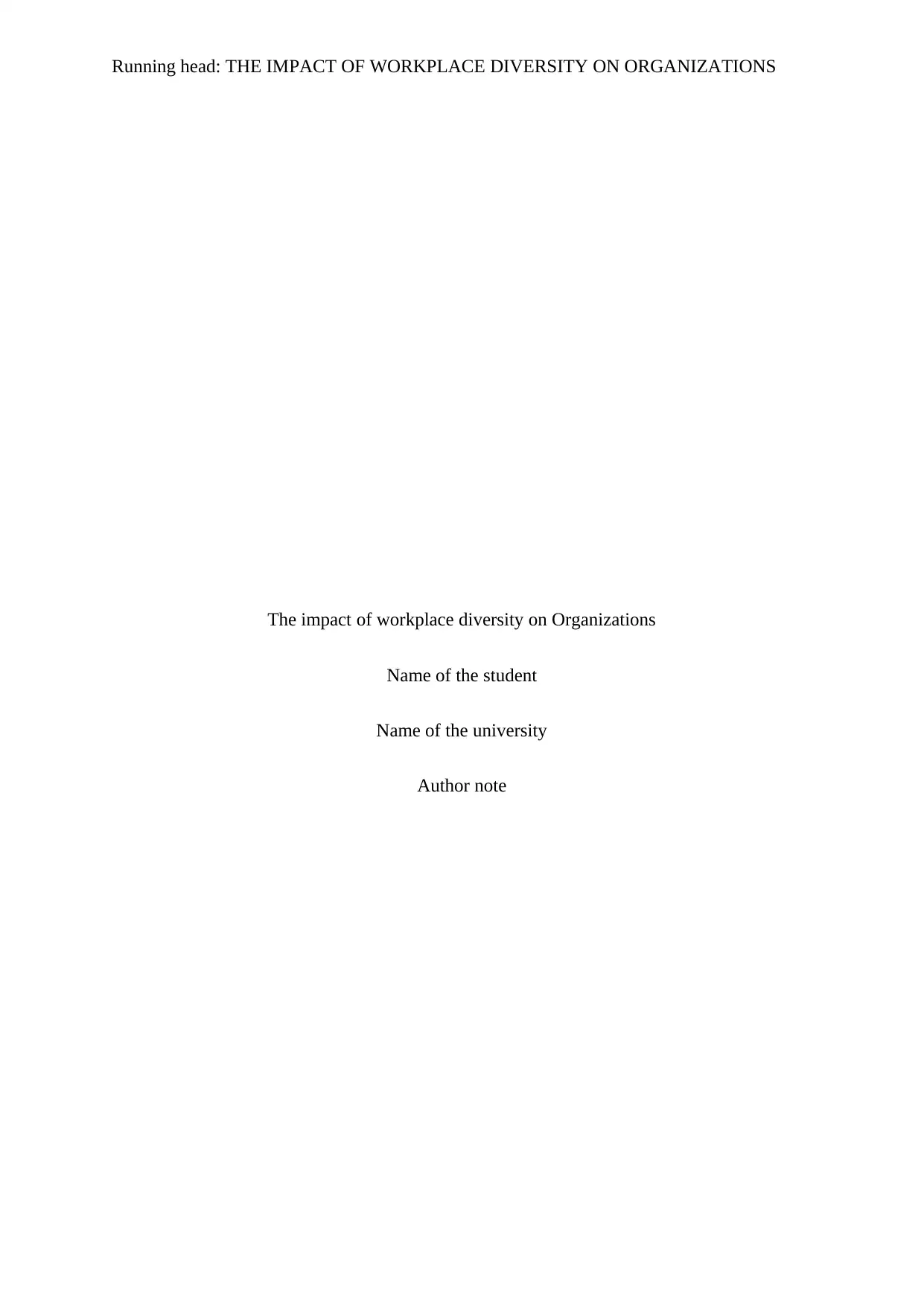
Running head: THE IMPACT OF WORKPLACE DIVERSITY ON ORGANIZATIONS
The impact of workplace diversity on Organizations
Name of the student
Name of the university
Author note
The impact of workplace diversity on Organizations
Name of the student
Name of the university
Author note
Paraphrase This Document
Need a fresh take? Get an instant paraphrase of this document with our AI Paraphraser
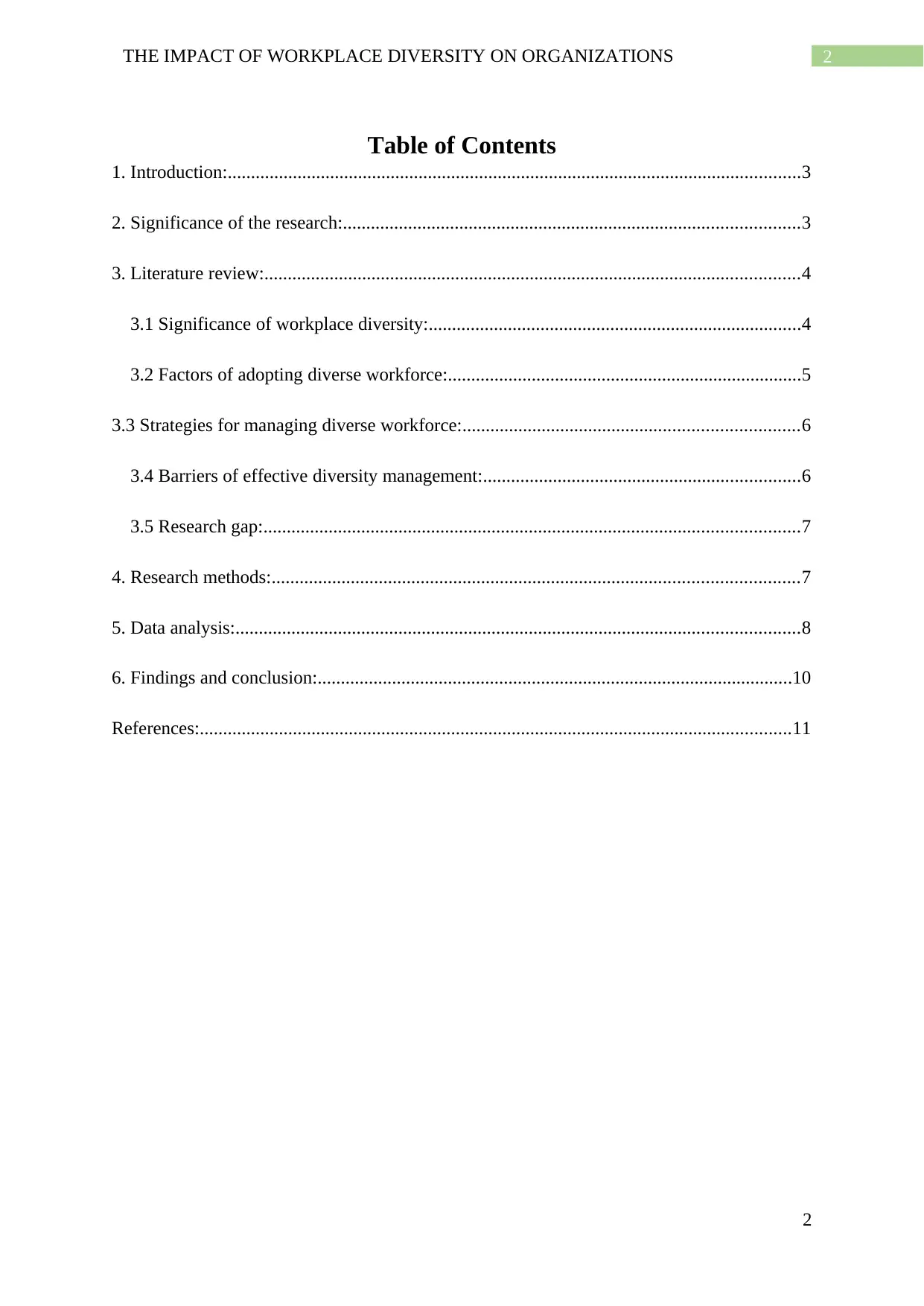
2THE IMPACT OF WORKPLACE DIVERSITY ON ORGANIZATIONS
Table of Contents
1. Introduction:...........................................................................................................................3
2. Significance of the research:..................................................................................................3
3. Literature review:...................................................................................................................4
3.1 Significance of workplace diversity:................................................................................4
3.2 Factors of adopting diverse workforce:............................................................................5
3.3 Strategies for managing diverse workforce:........................................................................6
3.4 Barriers of effective diversity management:....................................................................6
3.5 Research gap:...................................................................................................................7
4. Research methods:.................................................................................................................7
5. Data analysis:.........................................................................................................................8
6. Findings and conclusion:......................................................................................................10
References:...............................................................................................................................11
2
Table of Contents
1. Introduction:...........................................................................................................................3
2. Significance of the research:..................................................................................................3
3. Literature review:...................................................................................................................4
3.1 Significance of workplace diversity:................................................................................4
3.2 Factors of adopting diverse workforce:............................................................................5
3.3 Strategies for managing diverse workforce:........................................................................6
3.4 Barriers of effective diversity management:....................................................................6
3.5 Research gap:...................................................................................................................7
4. Research methods:.................................................................................................................7
5. Data analysis:.........................................................................................................................8
6. Findings and conclusion:......................................................................................................10
References:...............................................................................................................................11
2
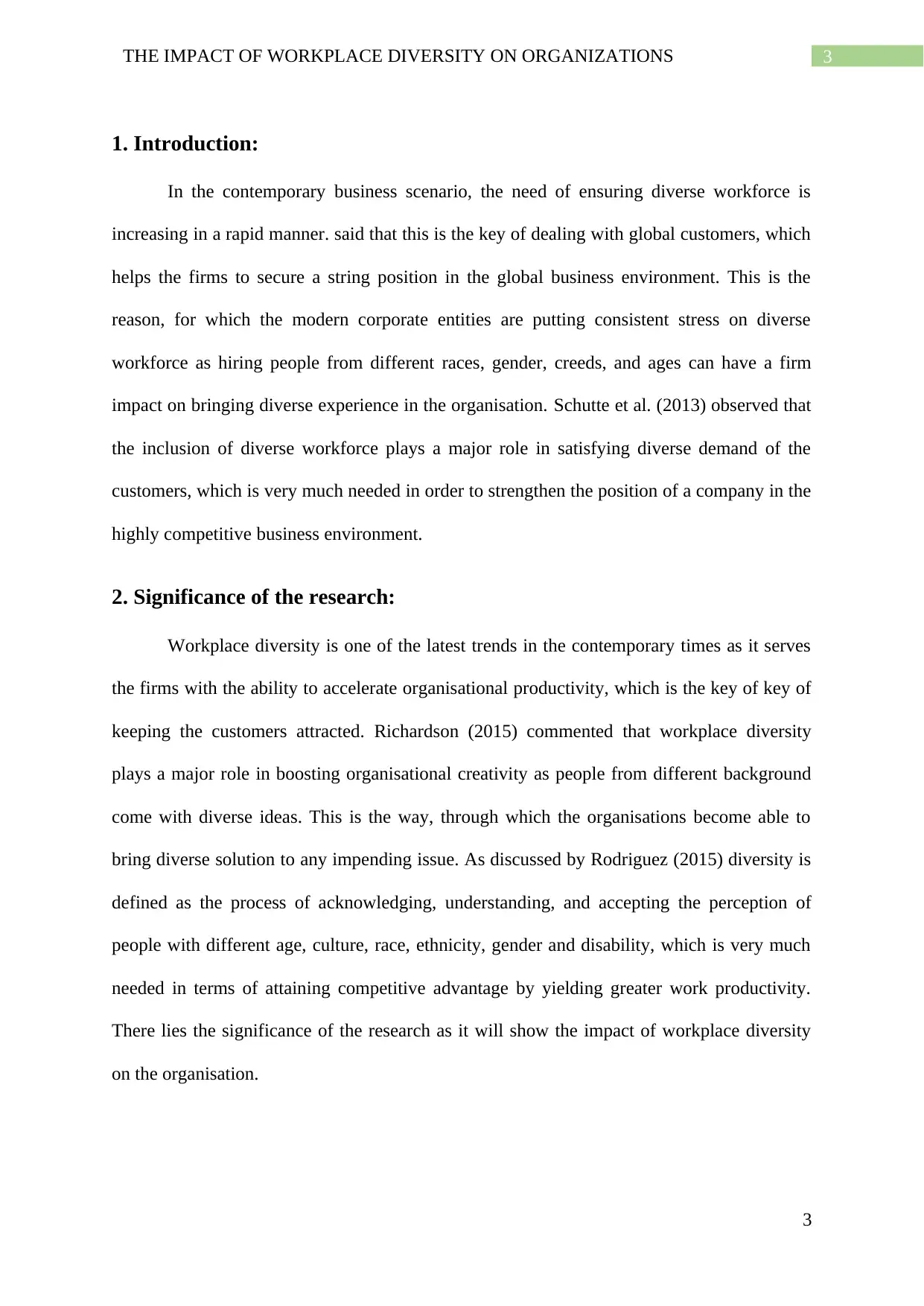
3THE IMPACT OF WORKPLACE DIVERSITY ON ORGANIZATIONS
1. Introduction:
In the contemporary business scenario, the need of ensuring diverse workforce is
increasing in a rapid manner. said that this is the key of dealing with global customers, which
helps the firms to secure a string position in the global business environment. This is the
reason, for which the modern corporate entities are putting consistent stress on diverse
workforce as hiring people from different races, gender, creeds, and ages can have a firm
impact on bringing diverse experience in the organisation. Schutte et al. (2013) observed that
the inclusion of diverse workforce plays a major role in satisfying diverse demand of the
customers, which is very much needed in order to strengthen the position of a company in the
highly competitive business environment.
2. Significance of the research:
Workplace diversity is one of the latest trends in the contemporary times as it serves
the firms with the ability to accelerate organisational productivity, which is the key of key of
keeping the customers attracted. Richardson (2015) commented that workplace diversity
plays a major role in boosting organisational creativity as people from different background
come with diverse ideas. This is the way, through which the organisations become able to
bring diverse solution to any impending issue. As discussed by Rodriguez (2015) diversity is
defined as the process of acknowledging, understanding, and accepting the perception of
people with different age, culture, race, ethnicity, gender and disability, which is very much
needed in terms of attaining competitive advantage by yielding greater work productivity.
There lies the significance of the research as it will show the impact of workplace diversity
on the organisation.
3
1. Introduction:
In the contemporary business scenario, the need of ensuring diverse workforce is
increasing in a rapid manner. said that this is the key of dealing with global customers, which
helps the firms to secure a string position in the global business environment. This is the
reason, for which the modern corporate entities are putting consistent stress on diverse
workforce as hiring people from different races, gender, creeds, and ages can have a firm
impact on bringing diverse experience in the organisation. Schutte et al. (2013) observed that
the inclusion of diverse workforce plays a major role in satisfying diverse demand of the
customers, which is very much needed in order to strengthen the position of a company in the
highly competitive business environment.
2. Significance of the research:
Workplace diversity is one of the latest trends in the contemporary times as it serves
the firms with the ability to accelerate organisational productivity, which is the key of key of
keeping the customers attracted. Richardson (2015) commented that workplace diversity
plays a major role in boosting organisational creativity as people from different background
come with diverse ideas. This is the way, through which the organisations become able to
bring diverse solution to any impending issue. As discussed by Rodriguez (2015) diversity is
defined as the process of acknowledging, understanding, and accepting the perception of
people with different age, culture, race, ethnicity, gender and disability, which is very much
needed in terms of attaining competitive advantage by yielding greater work productivity.
There lies the significance of the research as it will show the impact of workplace diversity
on the organisation.
3
⊘ This is a preview!⊘
Do you want full access?
Subscribe today to unlock all pages.

Trusted by 1+ million students worldwide
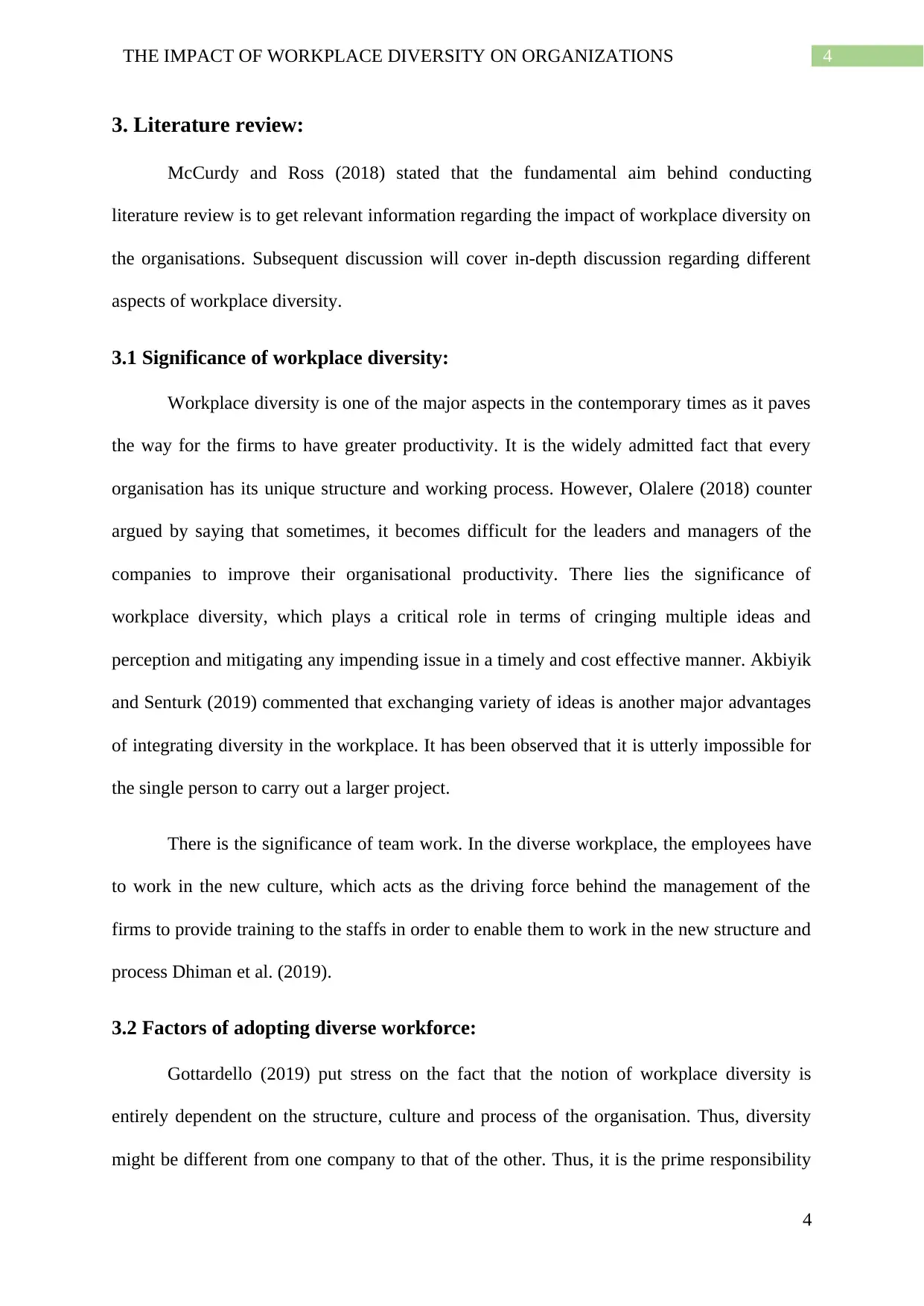
4THE IMPACT OF WORKPLACE DIVERSITY ON ORGANIZATIONS
3. Literature review:
McCurdy and Ross (2018) stated that the fundamental aim behind conducting
literature review is to get relevant information regarding the impact of workplace diversity on
the organisations. Subsequent discussion will cover in-depth discussion regarding different
aspects of workplace diversity.
3.1 Significance of workplace diversity:
Workplace diversity is one of the major aspects in the contemporary times as it paves
the way for the firms to have greater productivity. It is the widely admitted fact that every
organisation has its unique structure and working process. However, Olalere (2018) counter
argued by saying that sometimes, it becomes difficult for the leaders and managers of the
companies to improve their organisational productivity. There lies the significance of
workplace diversity, which plays a critical role in terms of cringing multiple ideas and
perception and mitigating any impending issue in a timely and cost effective manner. Akbiyik
and Senturk (2019) commented that exchanging variety of ideas is another major advantages
of integrating diversity in the workplace. It has been observed that it is utterly impossible for
the single person to carry out a larger project.
There is the significance of team work. In the diverse workplace, the employees have
to work in the new culture, which acts as the driving force behind the management of the
firms to provide training to the staffs in order to enable them to work in the new structure and
process Dhiman et al. (2019).
3.2 Factors of adopting diverse workforce:
Gottardello (2019) put stress on the fact that the notion of workplace diversity is
entirely dependent on the structure, culture and process of the organisation. Thus, diversity
might be different from one company to that of the other. Thus, it is the prime responsibility
4
3. Literature review:
McCurdy and Ross (2018) stated that the fundamental aim behind conducting
literature review is to get relevant information regarding the impact of workplace diversity on
the organisations. Subsequent discussion will cover in-depth discussion regarding different
aspects of workplace diversity.
3.1 Significance of workplace diversity:
Workplace diversity is one of the major aspects in the contemporary times as it paves
the way for the firms to have greater productivity. It is the widely admitted fact that every
organisation has its unique structure and working process. However, Olalere (2018) counter
argued by saying that sometimes, it becomes difficult for the leaders and managers of the
companies to improve their organisational productivity. There lies the significance of
workplace diversity, which plays a critical role in terms of cringing multiple ideas and
perception and mitigating any impending issue in a timely and cost effective manner. Akbiyik
and Senturk (2019) commented that exchanging variety of ideas is another major advantages
of integrating diversity in the workplace. It has been observed that it is utterly impossible for
the single person to carry out a larger project.
There is the significance of team work. In the diverse workplace, the employees have
to work in the new culture, which acts as the driving force behind the management of the
firms to provide training to the staffs in order to enable them to work in the new structure and
process Dhiman et al. (2019).
3.2 Factors of adopting diverse workforce:
Gottardello (2019) put stress on the fact that the notion of workplace diversity is
entirely dependent on the structure, culture and process of the organisation. Thus, diversity
might be different from one company to that of the other. Thus, it is the prime responsibility
4
Paraphrase This Document
Need a fresh take? Get an instant paraphrase of this document with our AI Paraphraser
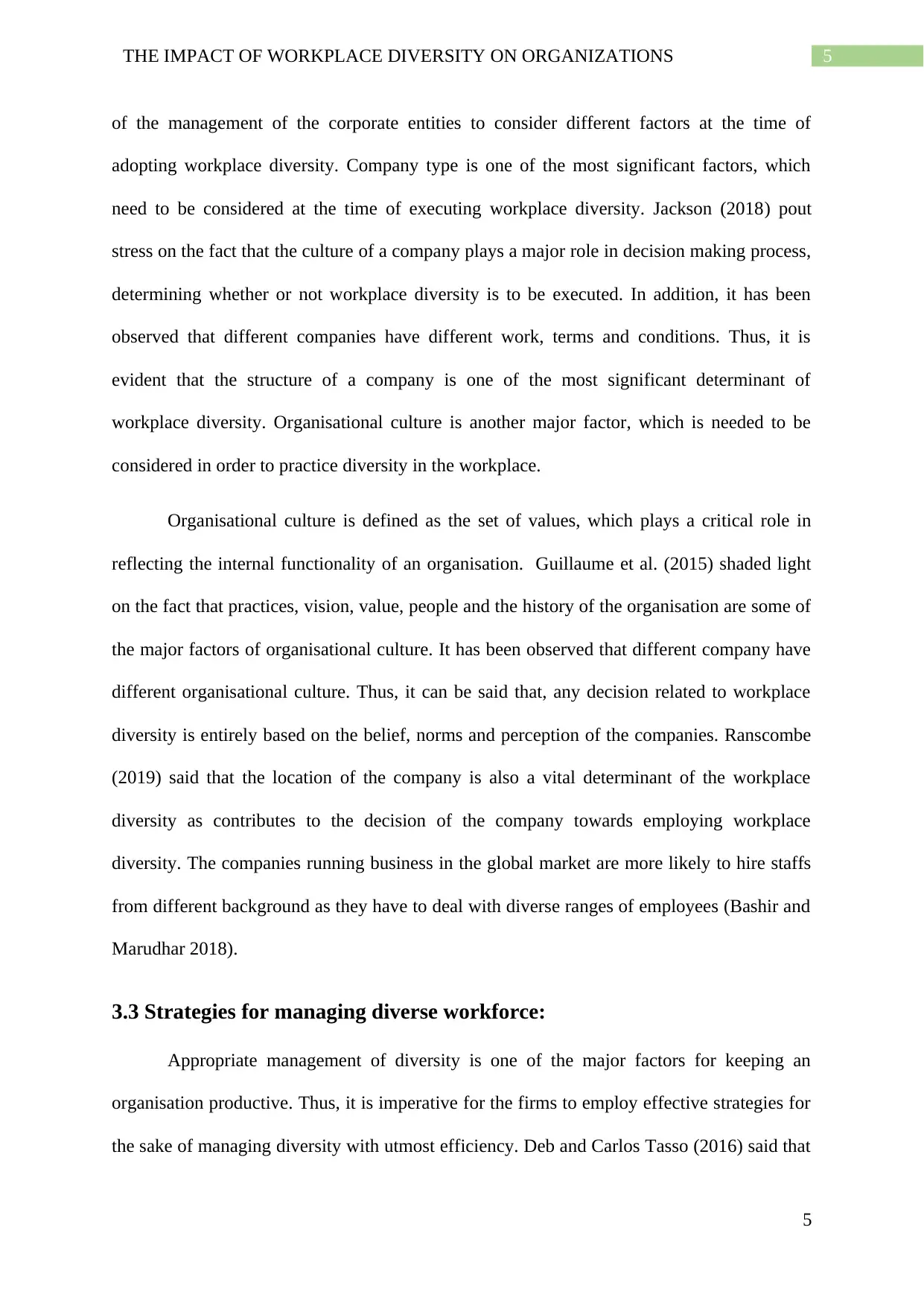
5THE IMPACT OF WORKPLACE DIVERSITY ON ORGANIZATIONS
of the management of the corporate entities to consider different factors at the time of
adopting workplace diversity. Company type is one of the most significant factors, which
need to be considered at the time of executing workplace diversity. Jackson (2018) pout
stress on the fact that the culture of a company plays a major role in decision making process,
determining whether or not workplace diversity is to be executed. In addition, it has been
observed that different companies have different work, terms and conditions. Thus, it is
evident that the structure of a company is one of the most significant determinant of
workplace diversity. Organisational culture is another major factor, which is needed to be
considered in order to practice diversity in the workplace.
Organisational culture is defined as the set of values, which plays a critical role in
reflecting the internal functionality of an organisation. Guillaume et al. (2015) shaded light
on the fact that practices, vision, value, people and the history of the organisation are some of
the major factors of organisational culture. It has been observed that different company have
different organisational culture. Thus, it can be said that, any decision related to workplace
diversity is entirely based on the belief, norms and perception of the companies. Ranscombe
(2019) said that the location of the company is also a vital determinant of the workplace
diversity as contributes to the decision of the company towards employing workplace
diversity. The companies running business in the global market are more likely to hire staffs
from different background as they have to deal with diverse ranges of employees (Bashir and
Marudhar 2018).
3.3 Strategies for managing diverse workforce:
Appropriate management of diversity is one of the major factors for keeping an
organisation productive. Thus, it is imperative for the firms to employ effective strategies for
the sake of managing diversity with utmost efficiency. Deb and Carlos Tasso (2016) said that
5
of the management of the corporate entities to consider different factors at the time of
adopting workplace diversity. Company type is one of the most significant factors, which
need to be considered at the time of executing workplace diversity. Jackson (2018) pout
stress on the fact that the culture of a company plays a major role in decision making process,
determining whether or not workplace diversity is to be executed. In addition, it has been
observed that different companies have different work, terms and conditions. Thus, it is
evident that the structure of a company is one of the most significant determinant of
workplace diversity. Organisational culture is another major factor, which is needed to be
considered in order to practice diversity in the workplace.
Organisational culture is defined as the set of values, which plays a critical role in
reflecting the internal functionality of an organisation. Guillaume et al. (2015) shaded light
on the fact that practices, vision, value, people and the history of the organisation are some of
the major factors of organisational culture. It has been observed that different company have
different organisational culture. Thus, it can be said that, any decision related to workplace
diversity is entirely based on the belief, norms and perception of the companies. Ranscombe
(2019) said that the location of the company is also a vital determinant of the workplace
diversity as contributes to the decision of the company towards employing workplace
diversity. The companies running business in the global market are more likely to hire staffs
from different background as they have to deal with diverse ranges of employees (Bashir and
Marudhar 2018).
3.3 Strategies for managing diverse workforce:
Appropriate management of diversity is one of the major factors for keeping an
organisation productive. Thus, it is imperative for the firms to employ effective strategies for
the sake of managing diversity with utmost efficiency. Deb and Carlos Tasso (2016) said that
5
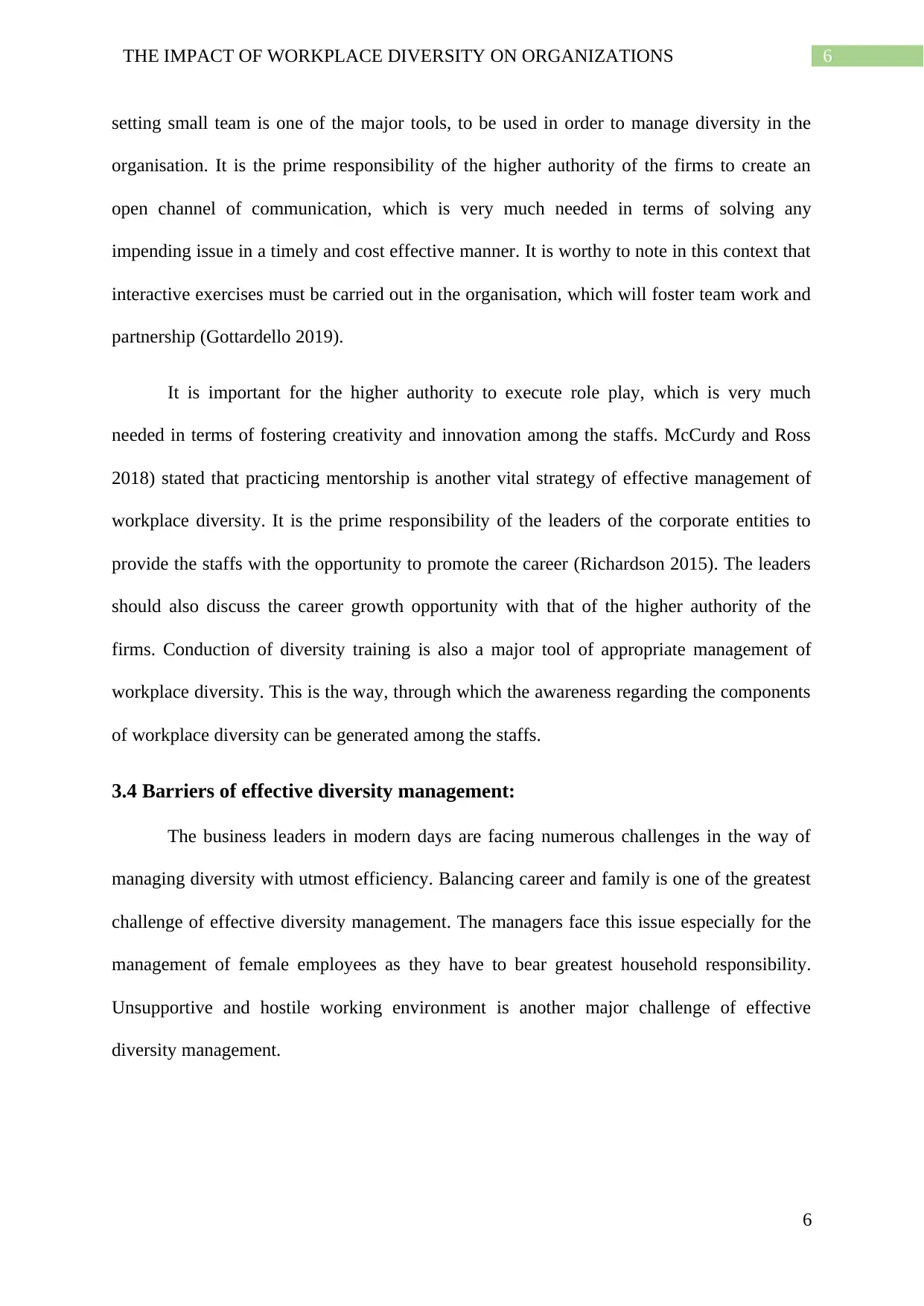
6THE IMPACT OF WORKPLACE DIVERSITY ON ORGANIZATIONS
setting small team is one of the major tools, to be used in order to manage diversity in the
organisation. It is the prime responsibility of the higher authority of the firms to create an
open channel of communication, which is very much needed in terms of solving any
impending issue in a timely and cost effective manner. It is worthy to note in this context that
interactive exercises must be carried out in the organisation, which will foster team work and
partnership (Gottardello 2019).
It is important for the higher authority to execute role play, which is very much
needed in terms of fostering creativity and innovation among the staffs. McCurdy and Ross
2018) stated that practicing mentorship is another vital strategy of effective management of
workplace diversity. It is the prime responsibility of the leaders of the corporate entities to
provide the staffs with the opportunity to promote the career (Richardson 2015). The leaders
should also discuss the career growth opportunity with that of the higher authority of the
firms. Conduction of diversity training is also a major tool of appropriate management of
workplace diversity. This is the way, through which the awareness regarding the components
of workplace diversity can be generated among the staffs.
3.4 Barriers of effective diversity management:
The business leaders in modern days are facing numerous challenges in the way of
managing diversity with utmost efficiency. Balancing career and family is one of the greatest
challenge of effective diversity management. The managers face this issue especially for the
management of female employees as they have to bear greatest household responsibility.
Unsupportive and hostile working environment is another major challenge of effective
diversity management.
6
setting small team is one of the major tools, to be used in order to manage diversity in the
organisation. It is the prime responsibility of the higher authority of the firms to create an
open channel of communication, which is very much needed in terms of solving any
impending issue in a timely and cost effective manner. It is worthy to note in this context that
interactive exercises must be carried out in the organisation, which will foster team work and
partnership (Gottardello 2019).
It is important for the higher authority to execute role play, which is very much
needed in terms of fostering creativity and innovation among the staffs. McCurdy and Ross
2018) stated that practicing mentorship is another vital strategy of effective management of
workplace diversity. It is the prime responsibility of the leaders of the corporate entities to
provide the staffs with the opportunity to promote the career (Richardson 2015). The leaders
should also discuss the career growth opportunity with that of the higher authority of the
firms. Conduction of diversity training is also a major tool of appropriate management of
workplace diversity. This is the way, through which the awareness regarding the components
of workplace diversity can be generated among the staffs.
3.4 Barriers of effective diversity management:
The business leaders in modern days are facing numerous challenges in the way of
managing diversity with utmost efficiency. Balancing career and family is one of the greatest
challenge of effective diversity management. The managers face this issue especially for the
management of female employees as they have to bear greatest household responsibility.
Unsupportive and hostile working environment is another major challenge of effective
diversity management.
6
⊘ This is a preview!⊘
Do you want full access?
Subscribe today to unlock all pages.

Trusted by 1+ million students worldwide
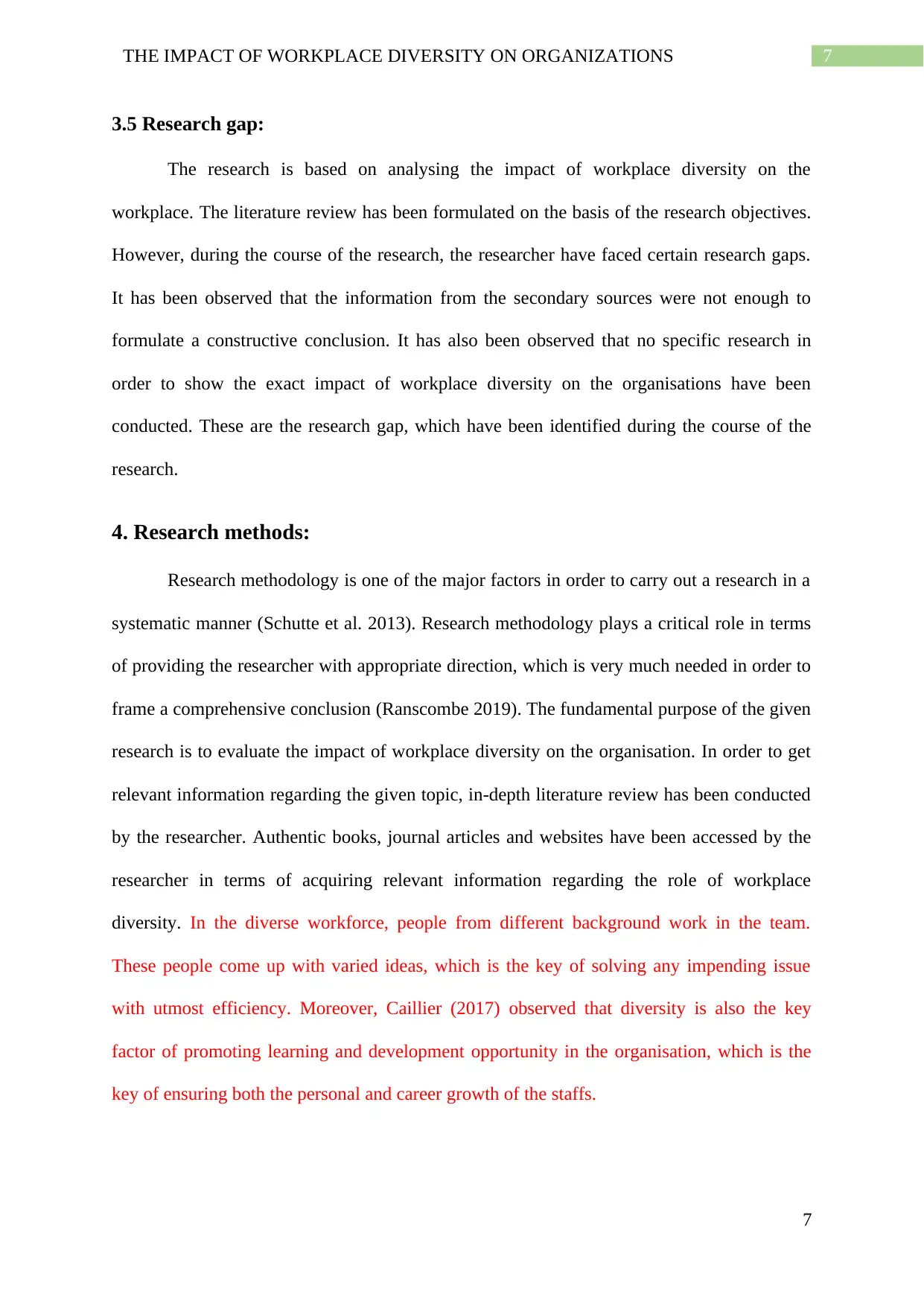
7THE IMPACT OF WORKPLACE DIVERSITY ON ORGANIZATIONS
3.5 Research gap:
The research is based on analysing the impact of workplace diversity on the
workplace. The literature review has been formulated on the basis of the research objectives.
However, during the course of the research, the researcher have faced certain research gaps.
It has been observed that the information from the secondary sources were not enough to
formulate a constructive conclusion. It has also been observed that no specific research in
order to show the exact impact of workplace diversity on the organisations have been
conducted. These are the research gap, which have been identified during the course of the
research.
4. Research methods:
Research methodology is one of the major factors in order to carry out a research in a
systematic manner (Schutte et al. 2013). Research methodology plays a critical role in terms
of providing the researcher with appropriate direction, which is very much needed in order to
frame a comprehensive conclusion (Ranscombe 2019). The fundamental purpose of the given
research is to evaluate the impact of workplace diversity on the organisation. In order to get
relevant information regarding the given topic, in-depth literature review has been conducted
by the researcher. Authentic books, journal articles and websites have been accessed by the
researcher in terms of acquiring relevant information regarding the role of workplace
diversity. In the diverse workforce, people from different background work in the team.
These people come up with varied ideas, which is the key of solving any impending issue
with utmost efficiency. Moreover, Caillier (2017) observed that diversity is also the key
factor of promoting learning and development opportunity in the organisation, which is the
key of ensuring both the personal and career growth of the staffs.
7
3.5 Research gap:
The research is based on analysing the impact of workplace diversity on the
workplace. The literature review has been formulated on the basis of the research objectives.
However, during the course of the research, the researcher have faced certain research gaps.
It has been observed that the information from the secondary sources were not enough to
formulate a constructive conclusion. It has also been observed that no specific research in
order to show the exact impact of workplace diversity on the organisations have been
conducted. These are the research gap, which have been identified during the course of the
research.
4. Research methods:
Research methodology is one of the major factors in order to carry out a research in a
systematic manner (Schutte et al. 2013). Research methodology plays a critical role in terms
of providing the researcher with appropriate direction, which is very much needed in order to
frame a comprehensive conclusion (Ranscombe 2019). The fundamental purpose of the given
research is to evaluate the impact of workplace diversity on the organisation. In order to get
relevant information regarding the given topic, in-depth literature review has been conducted
by the researcher. Authentic books, journal articles and websites have been accessed by the
researcher in terms of acquiring relevant information regarding the role of workplace
diversity. In the diverse workforce, people from different background work in the team.
These people come up with varied ideas, which is the key of solving any impending issue
with utmost efficiency. Moreover, Caillier (2017) observed that diversity is also the key
factor of promoting learning and development opportunity in the organisation, which is the
key of ensuring both the personal and career growth of the staffs.
7
Paraphrase This Document
Need a fresh take? Get an instant paraphrase of this document with our AI Paraphraser
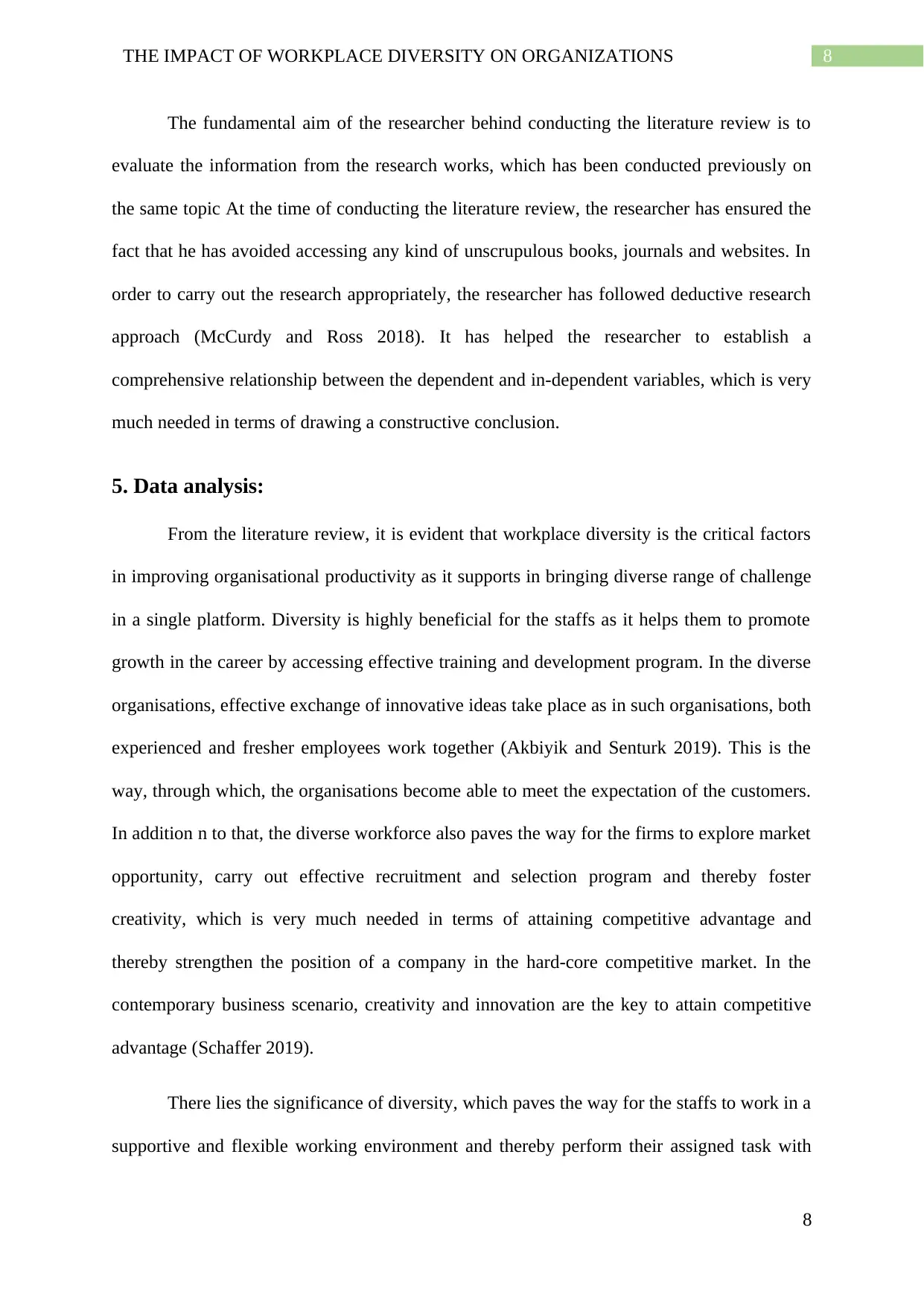
8THE IMPACT OF WORKPLACE DIVERSITY ON ORGANIZATIONS
The fundamental aim of the researcher behind conducting the literature review is to
evaluate the information from the research works, which has been conducted previously on
the same topic At the time of conducting the literature review, the researcher has ensured the
fact that he has avoided accessing any kind of unscrupulous books, journals and websites. In
order to carry out the research appropriately, the researcher has followed deductive research
approach (McCurdy and Ross 2018). It has helped the researcher to establish a
comprehensive relationship between the dependent and in-dependent variables, which is very
much needed in terms of drawing a constructive conclusion.
5. Data analysis:
From the literature review, it is evident that workplace diversity is the critical factors
in improving organisational productivity as it supports in bringing diverse range of challenge
in a single platform. Diversity is highly beneficial for the staffs as it helps them to promote
growth in the career by accessing effective training and development program. In the diverse
organisations, effective exchange of innovative ideas take place as in such organisations, both
experienced and fresher employees work together (Akbiyik and Senturk 2019). This is the
way, through which, the organisations become able to meet the expectation of the customers.
In addition n to that, the diverse workforce also paves the way for the firms to explore market
opportunity, carry out effective recruitment and selection program and thereby foster
creativity, which is very much needed in terms of attaining competitive advantage and
thereby strengthen the position of a company in the hard-core competitive market. In the
contemporary business scenario, creativity and innovation are the key to attain competitive
advantage (Schaffer 2019).
There lies the significance of diversity, which paves the way for the staffs to work in a
supportive and flexible working environment and thereby perform their assigned task with
8
The fundamental aim of the researcher behind conducting the literature review is to
evaluate the information from the research works, which has been conducted previously on
the same topic At the time of conducting the literature review, the researcher has ensured the
fact that he has avoided accessing any kind of unscrupulous books, journals and websites. In
order to carry out the research appropriately, the researcher has followed deductive research
approach (McCurdy and Ross 2018). It has helped the researcher to establish a
comprehensive relationship between the dependent and in-dependent variables, which is very
much needed in terms of drawing a constructive conclusion.
5. Data analysis:
From the literature review, it is evident that workplace diversity is the critical factors
in improving organisational productivity as it supports in bringing diverse range of challenge
in a single platform. Diversity is highly beneficial for the staffs as it helps them to promote
growth in the career by accessing effective training and development program. In the diverse
organisations, effective exchange of innovative ideas take place as in such organisations, both
experienced and fresher employees work together (Akbiyik and Senturk 2019). This is the
way, through which, the organisations become able to meet the expectation of the customers.
In addition n to that, the diverse workforce also paves the way for the firms to explore market
opportunity, carry out effective recruitment and selection program and thereby foster
creativity, which is very much needed in terms of attaining competitive advantage and
thereby strengthen the position of a company in the hard-core competitive market. In the
contemporary business scenario, creativity and innovation are the key to attain competitive
advantage (Schaffer 2019).
There lies the significance of diversity, which paves the way for the staffs to work in a
supportive and flexible working environment and thereby perform their assigned task with
8
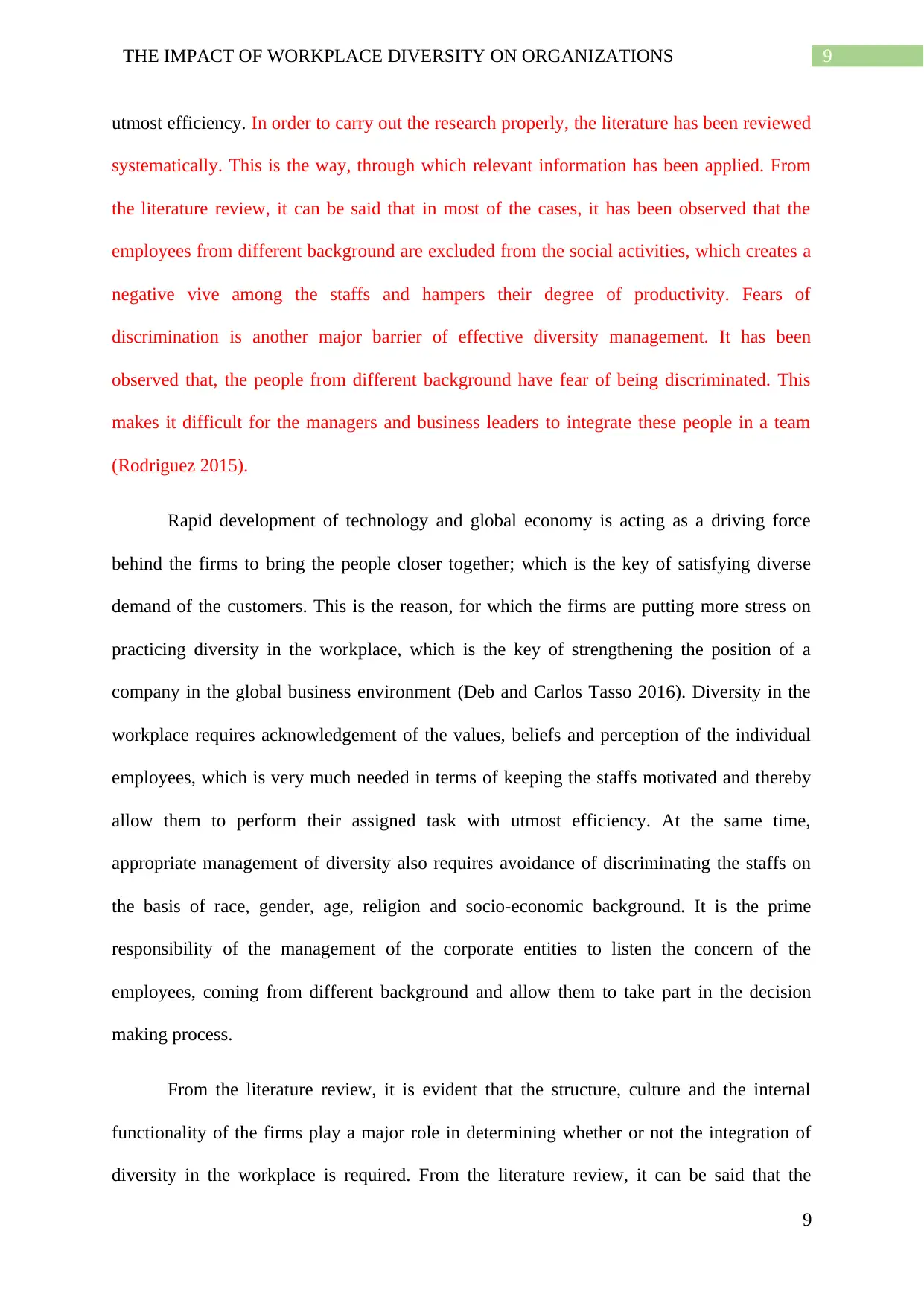
9THE IMPACT OF WORKPLACE DIVERSITY ON ORGANIZATIONS
utmost efficiency. In order to carry out the research properly, the literature has been reviewed
systematically. This is the way, through which relevant information has been applied. From
the literature review, it can be said that in most of the cases, it has been observed that the
employees from different background are excluded from the social activities, which creates a
negative vive among the staffs and hampers their degree of productivity. Fears of
discrimination is another major barrier of effective diversity management. It has been
observed that, the people from different background have fear of being discriminated. This
makes it difficult for the managers and business leaders to integrate these people in a team
(Rodriguez 2015).
Rapid development of technology and global economy is acting as a driving force
behind the firms to bring the people closer together; which is the key of satisfying diverse
demand of the customers. This is the reason, for which the firms are putting more stress on
practicing diversity in the workplace, which is the key of strengthening the position of a
company in the global business environment (Deb and Carlos Tasso 2016). Diversity in the
workplace requires acknowledgement of the values, beliefs and perception of the individual
employees, which is very much needed in terms of keeping the staffs motivated and thereby
allow them to perform their assigned task with utmost efficiency. At the same time,
appropriate management of diversity also requires avoidance of discriminating the staffs on
the basis of race, gender, age, religion and socio-economic background. It is the prime
responsibility of the management of the corporate entities to listen the concern of the
employees, coming from different background and allow them to take part in the decision
making process.
From the literature review, it is evident that the structure, culture and the internal
functionality of the firms play a major role in determining whether or not the integration of
diversity in the workplace is required. From the literature review, it can be said that the
9
utmost efficiency. In order to carry out the research properly, the literature has been reviewed
systematically. This is the way, through which relevant information has been applied. From
the literature review, it can be said that in most of the cases, it has been observed that the
employees from different background are excluded from the social activities, which creates a
negative vive among the staffs and hampers their degree of productivity. Fears of
discrimination is another major barrier of effective diversity management. It has been
observed that, the people from different background have fear of being discriminated. This
makes it difficult for the managers and business leaders to integrate these people in a team
(Rodriguez 2015).
Rapid development of technology and global economy is acting as a driving force
behind the firms to bring the people closer together; which is the key of satisfying diverse
demand of the customers. This is the reason, for which the firms are putting more stress on
practicing diversity in the workplace, which is the key of strengthening the position of a
company in the global business environment (Deb and Carlos Tasso 2016). Diversity in the
workplace requires acknowledgement of the values, beliefs and perception of the individual
employees, which is very much needed in terms of keeping the staffs motivated and thereby
allow them to perform their assigned task with utmost efficiency. At the same time,
appropriate management of diversity also requires avoidance of discriminating the staffs on
the basis of race, gender, age, religion and socio-economic background. It is the prime
responsibility of the management of the corporate entities to listen the concern of the
employees, coming from different background and allow them to take part in the decision
making process.
From the literature review, it is evident that the structure, culture and the internal
functionality of the firms play a major role in determining whether or not the integration of
diversity in the workplace is required. From the literature review, it can be said that the
9
⊘ This is a preview!⊘
Do you want full access?
Subscribe today to unlock all pages.

Trusted by 1+ million students worldwide
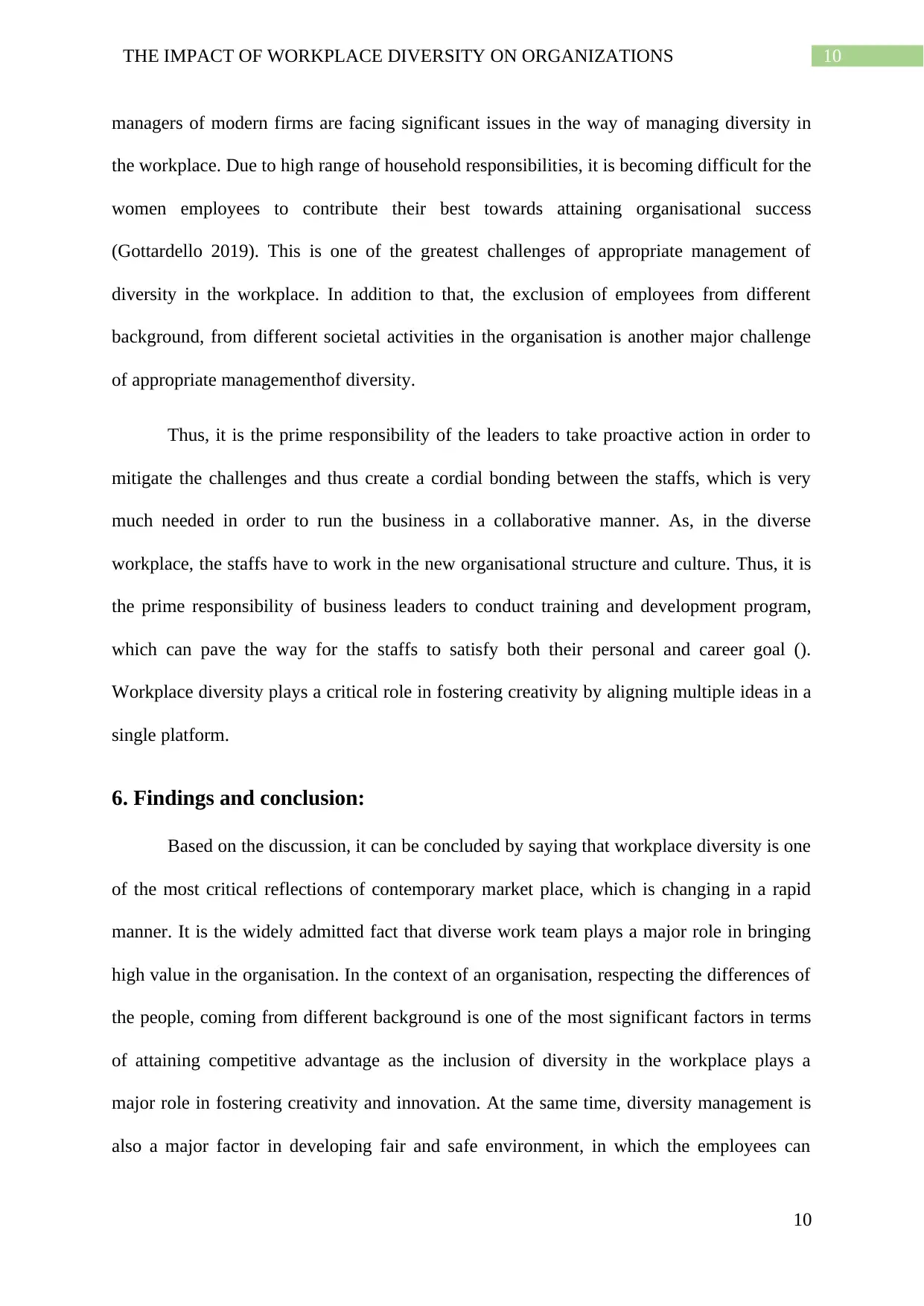
10THE IMPACT OF WORKPLACE DIVERSITY ON ORGANIZATIONS
managers of modern firms are facing significant issues in the way of managing diversity in
the workplace. Due to high range of household responsibilities, it is becoming difficult for the
women employees to contribute their best towards attaining organisational success
(Gottardello 2019). This is one of the greatest challenges of appropriate management of
diversity in the workplace. In addition to that, the exclusion of employees from different
background, from different societal activities in the organisation is another major challenge
of appropriate managementhof diversity.
Thus, it is the prime responsibility of the leaders to take proactive action in order to
mitigate the challenges and thus create a cordial bonding between the staffs, which is very
much needed in order to run the business in a collaborative manner. As, in the diverse
workplace, the staffs have to work in the new organisational structure and culture. Thus, it is
the prime responsibility of business leaders to conduct training and development program,
which can pave the way for the staffs to satisfy both their personal and career goal ().
Workplace diversity plays a critical role in fostering creativity by aligning multiple ideas in a
single platform.
6. Findings and conclusion:
Based on the discussion, it can be concluded by saying that workplace diversity is one
of the most critical reflections of contemporary market place, which is changing in a rapid
manner. It is the widely admitted fact that diverse work team plays a major role in bringing
high value in the organisation. In the context of an organisation, respecting the differences of
the people, coming from different background is one of the most significant factors in terms
of attaining competitive advantage as the inclusion of diversity in the workplace plays a
major role in fostering creativity and innovation. At the same time, diversity management is
also a major factor in developing fair and safe environment, in which the employees can
10
managers of modern firms are facing significant issues in the way of managing diversity in
the workplace. Due to high range of household responsibilities, it is becoming difficult for the
women employees to contribute their best towards attaining organisational success
(Gottardello 2019). This is one of the greatest challenges of appropriate management of
diversity in the workplace. In addition to that, the exclusion of employees from different
background, from different societal activities in the organisation is another major challenge
of appropriate managementhof diversity.
Thus, it is the prime responsibility of the leaders to take proactive action in order to
mitigate the challenges and thus create a cordial bonding between the staffs, which is very
much needed in order to run the business in a collaborative manner. As, in the diverse
workplace, the staffs have to work in the new organisational structure and culture. Thus, it is
the prime responsibility of business leaders to conduct training and development program,
which can pave the way for the staffs to satisfy both their personal and career goal ().
Workplace diversity plays a critical role in fostering creativity by aligning multiple ideas in a
single platform.
6. Findings and conclusion:
Based on the discussion, it can be concluded by saying that workplace diversity is one
of the most critical reflections of contemporary market place, which is changing in a rapid
manner. It is the widely admitted fact that diverse work team plays a major role in bringing
high value in the organisation. In the context of an organisation, respecting the differences of
the people, coming from different background is one of the most significant factors in terms
of attaining competitive advantage as the inclusion of diversity in the workplace plays a
major role in fostering creativity and innovation. At the same time, diversity management is
also a major factor in developing fair and safe environment, in which the employees can
10
Paraphrase This Document
Need a fresh take? Get an instant paraphrase of this document with our AI Paraphraser
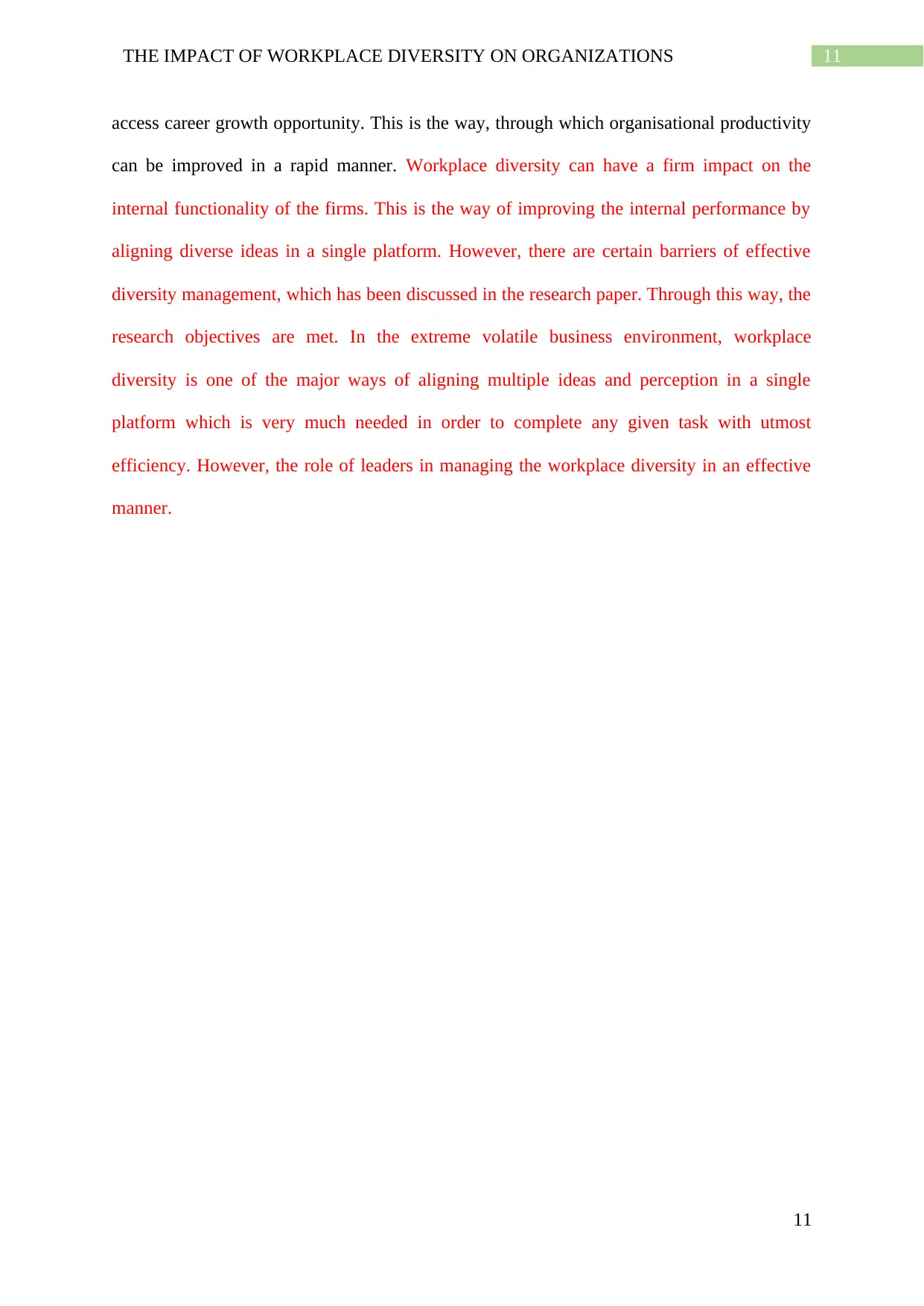
11THE IMPACT OF WORKPLACE DIVERSITY ON ORGANIZATIONS
access career growth opportunity. This is the way, through which organisational productivity
can be improved in a rapid manner. Workplace diversity can have a firm impact on the
internal functionality of the firms. This is the way of improving the internal performance by
aligning diverse ideas in a single platform. However, there are certain barriers of effective
diversity management, which has been discussed in the research paper. Through this way, the
research objectives are met. In the extreme volatile business environment, workplace
diversity is one of the major ways of aligning multiple ideas and perception in a single
platform which is very much needed in order to complete any given task with utmost
efficiency. However, the role of leaders in managing the workplace diversity in an effective
manner.
11
access career growth opportunity. This is the way, through which organisational productivity
can be improved in a rapid manner. Workplace diversity can have a firm impact on the
internal functionality of the firms. This is the way of improving the internal performance by
aligning diverse ideas in a single platform. However, there are certain barriers of effective
diversity management, which has been discussed in the research paper. Through this way, the
research objectives are met. In the extreme volatile business environment, workplace
diversity is one of the major ways of aligning multiple ideas and perception in a single
platform which is very much needed in order to complete any given task with utmost
efficiency. However, the role of leaders in managing the workplace diversity in an effective
manner.
11
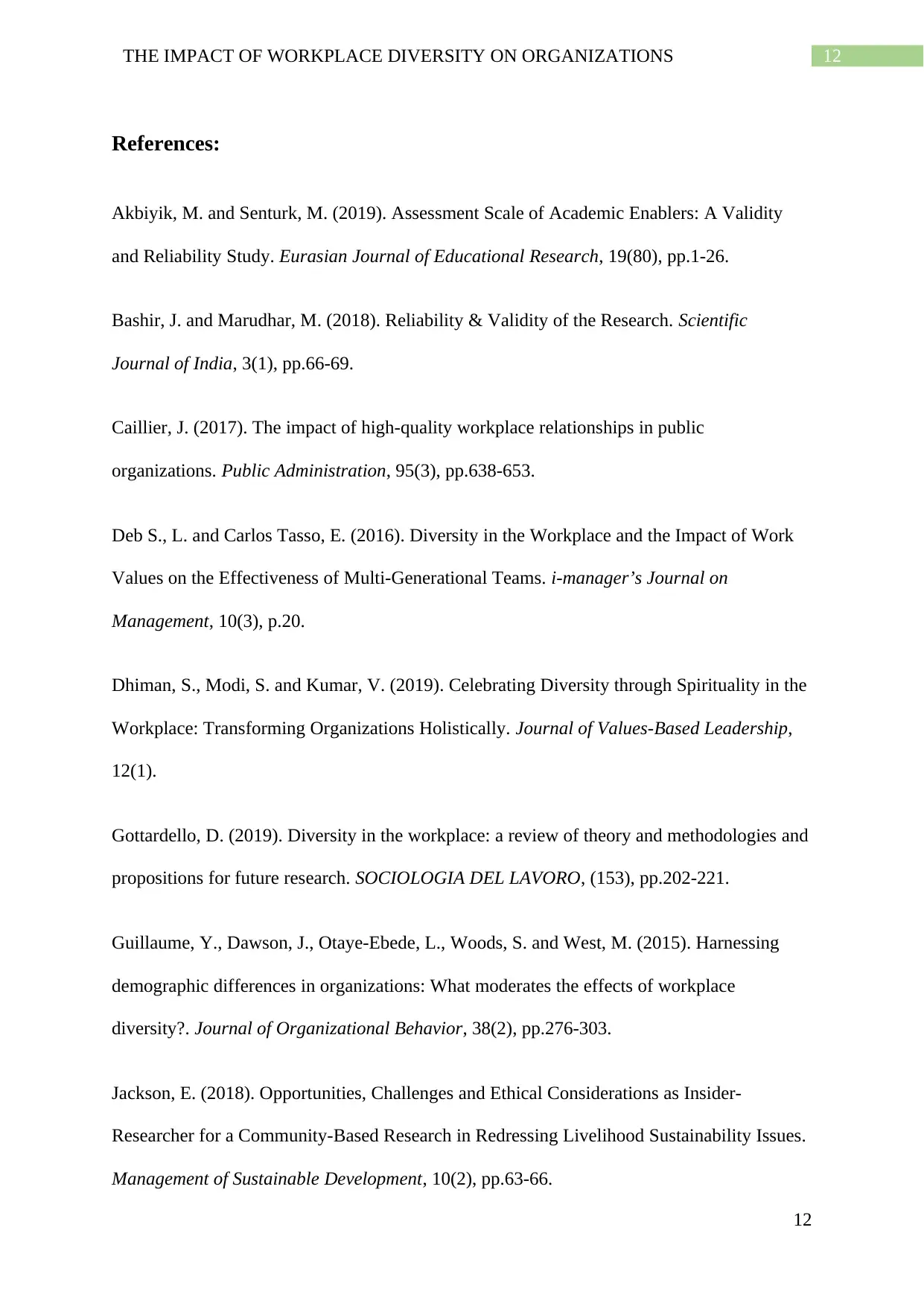
12THE IMPACT OF WORKPLACE DIVERSITY ON ORGANIZATIONS
References:
Akbiyik, M. and Senturk, M. (2019). Assessment Scale of Academic Enablers: A Validity
and Reliability Study. Eurasian Journal of Educational Research, 19(80), pp.1-26.
Bashir, J. and Marudhar, M. (2018). Reliability & Validity of the Research. Scientific
Journal of India, 3(1), pp.66-69.
Caillier, J. (2017). The impact of high-quality workplace relationships in public
organizations. Public Administration, 95(3), pp.638-653.
Deb S., L. and Carlos Tasso, E. (2016). Diversity in the Workplace and the Impact of Work
Values on the Effectiveness of Multi-Generational Teams. i-manager’s Journal on
Management, 10(3), p.20.
Dhiman, S., Modi, S. and Kumar, V. (2019). Celebrating Diversity through Spirituality in the
Workplace: Transforming Organizations Holistically. Journal of Values-Based Leadership,
12(1).
Gottardello, D. (2019). Diversity in the workplace: a review of theory and methodologies and
propositions for future research. SOCIOLOGIA DEL LAVORO, (153), pp.202-221.
Guillaume, Y., Dawson, J., Otaye-Ebede, L., Woods, S. and West, M. (2015). Harnessing
demographic differences in organizations: What moderates the effects of workplace
diversity?. Journal of Organizational Behavior, 38(2), pp.276-303.
Jackson, E. (2018). Opportunities, Challenges and Ethical Considerations as Insider-
Researcher for a Community-Based Research in Redressing Livelihood Sustainability Issues.
Management of Sustainable Development, 10(2), pp.63-66.
12
References:
Akbiyik, M. and Senturk, M. (2019). Assessment Scale of Academic Enablers: A Validity
and Reliability Study. Eurasian Journal of Educational Research, 19(80), pp.1-26.
Bashir, J. and Marudhar, M. (2018). Reliability & Validity of the Research. Scientific
Journal of India, 3(1), pp.66-69.
Caillier, J. (2017). The impact of high-quality workplace relationships in public
organizations. Public Administration, 95(3), pp.638-653.
Deb S., L. and Carlos Tasso, E. (2016). Diversity in the Workplace and the Impact of Work
Values on the Effectiveness of Multi-Generational Teams. i-manager’s Journal on
Management, 10(3), p.20.
Dhiman, S., Modi, S. and Kumar, V. (2019). Celebrating Diversity through Spirituality in the
Workplace: Transforming Organizations Holistically. Journal of Values-Based Leadership,
12(1).
Gottardello, D. (2019). Diversity in the workplace: a review of theory and methodologies and
propositions for future research. SOCIOLOGIA DEL LAVORO, (153), pp.202-221.
Guillaume, Y., Dawson, J., Otaye-Ebede, L., Woods, S. and West, M. (2015). Harnessing
demographic differences in organizations: What moderates the effects of workplace
diversity?. Journal of Organizational Behavior, 38(2), pp.276-303.
Jackson, E. (2018). Opportunities, Challenges and Ethical Considerations as Insider-
Researcher for a Community-Based Research in Redressing Livelihood Sustainability Issues.
Management of Sustainable Development, 10(2), pp.63-66.
12
⊘ This is a preview!⊘
Do you want full access?
Subscribe today to unlock all pages.

Trusted by 1+ million students worldwide
1 out of 13
Related Documents
Your All-in-One AI-Powered Toolkit for Academic Success.
+13062052269
info@desklib.com
Available 24*7 on WhatsApp / Email
![[object Object]](/_next/static/media/star-bottom.7253800d.svg)
Unlock your academic potential
Copyright © 2020–2025 A2Z Services. All Rights Reserved. Developed and managed by ZUCOL.




